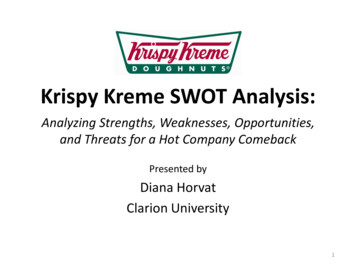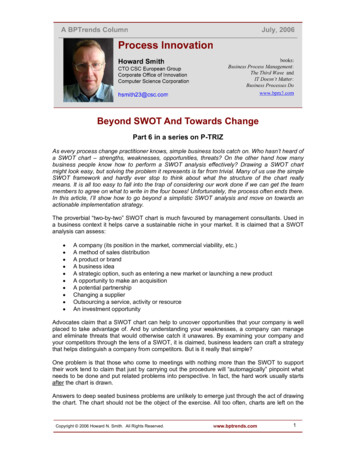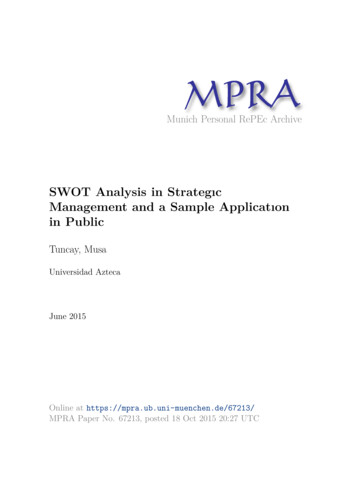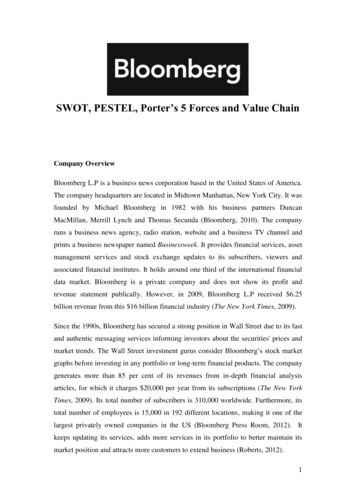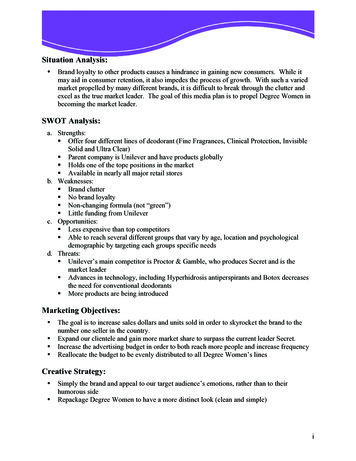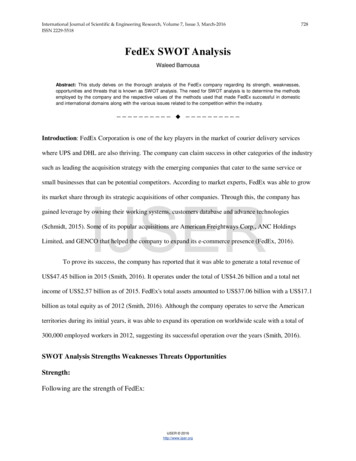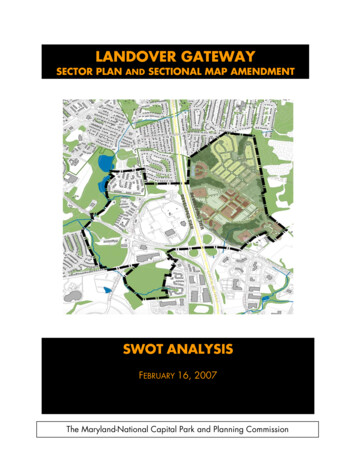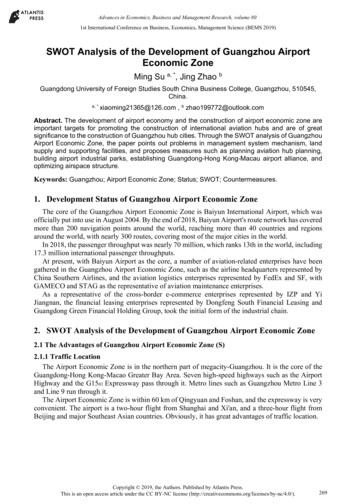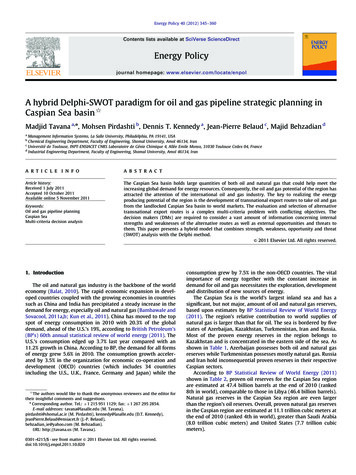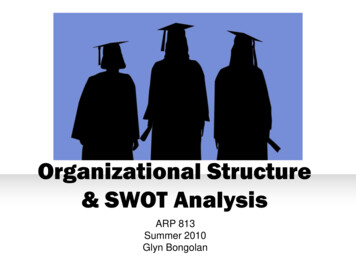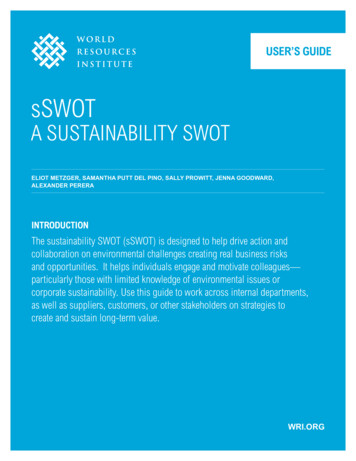
Transcription
user’s guidesswota sustainability swotEliot Metzger, Samantha Putt del Pino, Sally Prowitt, Jenna Goodward,Alexander PereraIntroductionThe sustainability SWOT (sSWOT) is designed to help drive action andcollaboration on environmental challenges creating real business risksand opportunities. It helps individuals engage and motivate colleagues—particularly those with limited knowledge of environmental issues orcorporate sustainability. Use this guide to work across internal departments,as well as suppliers, customers, or other stakeholders on strategies tocreate and sustain long-term value.WRI.ORG
SUSTAINABILITY SWOT(sSWOT) What can we do in the near-term, mid-term, and long-term? Which insights will influenceor keep him/her up at night? Who else has similar weaknesses or facessimilar risks from environmental challenges?What are unexpected ways we can applyour strengths to environmental challenges?Where is there a growing gap where we andothers can create new solutions forenvironmental challenges?Where are environmental challengescreating broad threats to futurebusiness value?What do you and otherssee RTUNITIESTHREATS32ENVIRONMENTAL CHALLENGES AND BIG TRENDSWhat (or who) doyou want to inform?2 1
sSWOT: A Sustainability SWOTA Message from the “Road Test” CompaniesWe accepted an invitation from the World Resources Institute (WRI) to review and test an early version of the sustainability SWOT (or sSWOT). We found the sSWOT to be a powerful means of showing how environmental challenges canshape strategic risks and opportunities.We applied the sSWOT at our organizations in different ways and some of our stories are included in this guide.We urge others to use it to collaborate with internal colleagues and external partners (suppliers, customers, andeven competitors).The sSWOT can help you assess options for action—together with colleagues and partners—on the environmentalchallenges creating new business risks and opportunities.Jorge Soto, Director, Sustainable DevelopmentBrazilian multinational chemicals companyand largest producer of thermoplastic resinsin the AmericasKyle Crider, Manager of EnvironmentalOperationsOwner and operator of 30 private institutionsof higher education located throughout theUnited StatesMark Buckley, Vice President,Environmental AffairsWorld’s largest office products company andsecond largest internet retailerthe logo is intended tobleed off the top left handcorner of the page.the dots should line up withthe page edge, allow 3mmbleed and pull in the picturebox to hide the dots.Stephen Bickell, Sustainability TutorUK-based provider of supported distancelearning for real estate and constructionprofessionalsLucas Urbano, Sustainability ManagerThe Brazilian Dairy division of the dairy andnutritional products company, Group DanoneKimberly Bowden, EH&S Sustainability ManagerGlobal supplier of electronics and technologiesfor automotive, commercial vehicle andother sectorsDrummond Lawson, green giant(director of sustainability)San Francisco-based producer of home cleaning,laundry and hand care productsGabriela Burian, Director, SustainableAgriculture EcosystemsGlobal provider of technology-based solutionsand agricultural products to improve farmproductivity and food qualityPéricles S. Weber, Environment DirectorWater and sanitation services provider for thestate of Paraná in BrazilKatie Dillon, Manager, Corporate SustainabilityNorth American-based upscale discount retailerRick Love, Manager, Environmental SustainabilityProvider of innovative, high-technology productsand services to the aerospace and buildingsystems industries worldwideRobyn Luhning, Environmentaland Social Risk ManagerDiversified financial services company headquartered in the U.S. with offices in more than35 countriesAmanda Kardosh, Sustainability ManagerBrazil-based fleet management company witha customer portfolio of approximately half amillion vehiclesuser’s guide December 2012 3
TABLE OF CONTENTSABOUT THE sSWOTINTRODUCTION. 51. WHERE TO START. 82. ENVIRONMENTALCHALLENGES. 103. THREATS. 134. OPPORTUNITIES. 145. STRENGTHS. 166. WEAKNESSES. 177. WHAT TO PRIORITIZE. 188. WHERE TO ACT. 19ACKNOWLEDGMENTS. 21REFERENCES. 22The World Resources Institute(WRI) created the sustainabilitySWOT (sSWOT) to help companiestake action on environmentalchallenges.* It pushes companies toexplore collaboration with internaldepartments, as well as suppliers,customers, or other stakeholders onstrategies to create and sustain longterm value.The sSWOT can help engage andmotivate colleagues—particularlythose with limited knowledgeof environmental issues orcorporate sustainability. Mostimportantly, it can help identifyand communicate new insights tosenior decision makers.In partnership with companies inWRI’s Next Practice Collaborative,and through workshops, road tests,**and interviews with dozens ofcompanies and sustainabilityexperts, we put a new twist on thefamiliar SWOT (Strengths, Weaknesses, Opportunities, Threats) tohelp you: Evaluate your company’s strategies and translate insights aboutenvironmental challenges (forexample, climate change andresource scarcity) into risks oropportunities that your companycan act on. Get others motivated aboutopportunities to invest, innovate,and collaborate on environmentalchallenges in ways that increasebusiness value. Convince colleagues and decisionmakers (for example, senior managers, CEOs, CFOs, or Boardsof Directors) that environmentalchallenges are not as far removedfrom your company’s core interests as may be assumed.FOOTNOTES* Sustainability, as a concept, is much broaderthan environmental issues. This guide providesa flexible framework to help business translateenvironmental challenges into core businessinterests and strategies. Social concerns (forexample, human rights and labor standards) canbe included in the analysis by supplementingthe questions and considerations highlighted inthis guide.** See the “Insights from Road Tests” boxes forexamples and experiences of individuals whopilot tested the sSWOT at their companies.4
sSWOT: A Sustainability SWOTintroductionBig changesThe concept of sustainability—meeting today’s needs withoutjeopardizing the ability of futuregenerations to meet their needs1—is penetrating board rooms acrossmultiple industries.2 It is nowdiscussed in leading businessjournals, like the Harvard BusinessReview and the MIT Sloan Management Review, as a major driver ofbusiness innovation and competitiveadvantage.3 It is increasinglyinfluencing business value andbusiness decisions.4Sustainability directors wantto demonstrate to colleagues,customers, and suppliersthat environmental challengesare not removed from corebusiness interests.Sustainability directors fromcompanies across multiple sectorshave told WRI they are looking for away to communicate and collaboratewith others on environmental challenges. They want to demonstrateto colleagues, customers, andsuppliers that environmentalchallenges are not removed fromcore business interests. They needa means of drawing connectionsto the other trends (for example,economic or demographic changes)that business unit managers, seniorexecutives, or boards of directors aremore familiar with.are growing and flocking to cities.By 2030, urban areas will be hometo more than a billion additionalpeople. In that time, there are projected to be two billion new middleclass consumers, along with billionsmore low-income consumers, ingrowing markets around the world.Meanwhile, today’s technologiesare creating new opportunities. Takethe rapid growth in information,computing and mobile communication technologies. These and otherinnovations create new possibilitiesfor disruptive business models,strategies, and partnerships.Sustainability connects long-termenvironmental and social challengeswith economic priorities (for thepurposes of this guide, the emphasisis on environmental challenges).Companies can look at theseconnections for important businessrisks as well as opportunities toprovide new solutions (see Box 1).Corporate sustainability championsare looking for ways to act on thesechanges. They are finding waysto change internal operations andprocesses to address environmental challenges, minimize costs, andimprove productivity. They areseeking opportunities to generatenew revenue with products andservices that create or use cleanerenergy and safer materials, andconserve natural resources. They arecollaborating with others to preserveand create business value (see Box2). They have helped WRI create aConsider the big trends—“megatrends” or “metatrends”—that are transforming marketsand creating new ways to meetcustomers’ future needs. Populationspractical and compelling frameworkto translate environmental challenges into risks or opportunitiesthat their company can act on.Adding an “s” to SWOTA sustainability SWOT (or sSWOT)provides a new twist on the familiarstrategic analysis framework. It isa comfortable format for starting aconversation, but it is designed tohelp push colleagues into unexploredterritory. It encourages teams toconsider broader connections andopportunities for collaboration insideand outside the company. It challenges teams and decision makersto think about the long-term environmental challenges (like climatechange or natural resource scarcity)that will be creating significantbusiness risks or opportunities inthe years ahead.Such changes could arguably fitinto a traditional SWOT analysis: anassessment of a company’s internalstrengths and weaknesses, in relation to the external opportunitiesand threats. However, a study onconducting SWOT analyses with aspecial emphasis on sustainabilityuser’s guide December 2012 5
Start with the big picture, thenfocus on the firm: The sSWOTbegins with threats and opportunities and pushes teams tothink beyond the company’s fourwalls. It emphasizes connectionsbetween environmental challenges and other trends creatingbig changes in future markets.After starting big, the sSWOTanalysis narrows to the companylevel by drawing connectionsto strengths, weaknesses, andpriority action items. Think broadly to create newvalue or assess value at risk:The sSWOT focuses on howenvironmental threats impactnot just the company, but otherimportant stakeholders, likecustomers and communities.These can represent risks, as wellas opportunities to create newsolutions for the business andthe environment. Find a “collaborative edge” byleveraging core competenciesand addressing vulnerabilities with partners: The sSWOTemphasizes strengths that acompany already has and thosea company can build by collaborating with others (companies,customers, suppliers, communities). Likewise, it emphasizesweaknesses that a company canaddress with other stakeholders(and in some cases, competitors).Companies which “road-tested”the sSWOT note that it creates a“common language” for engagingcolleagues and a “bridge” forthinking about a company’s currentoperations and where it needs to beto be competitive in future markets.Companies which “road-tested” thesSWOT note that it creates a “commonlanguage” for engaging colleaguesand a “bridge” for thinking about acompany’s current operations.6 box 1and life-cycle analysis showed thatcompanies can identify new risks andopportunities, as well as new waysof communicating complex issuesto colleagues.5 WRI’s sSWOT adaptsand strengthens the traditionalSWOT by prompting teams to:business thoughtleaders: thinkbigger andbroader tofind risks andopportunitiesThe late C.K. Prahalad—whochampioned the concept of “corecompetency”—pointed out thatbig social and environmentalchallenges present immenseuntapped market opportunitiesfor new products, services, andbusiness models. He urged companies to create next practicessince incremental improvementson existing best practices wouldnot be enough to tackle thesechallenges. Companies shouldthink ahead and think evenbigger:Next practices are all aboutinnovation: imagining what thefuture will look like; identifyingthe mega-opportunities that willarise; and building capabilities tocapitalize on them.6Similarly, Michael Porter—thefather of modern corporate strategy—suggests companies shouldthink broadly about society’sbig challenges and identify linksbetween business interests andcommunities’ interests. He andhis colleagues point to sharedvalue as a driver of innovationand business growth:The opportunities have beenthere all along, but have beenoverlooked Society’s needsare large and growing, whilecustomers, employees, and anew generation of young peopleare asking business to step up.7
box 2sSWOT: A Sustainability SWOTthink bigger and broader to find risks and opportunitiesA study by the MIT Sloan ManagementReview and Boston Consulting Group showedthat companies deriving profits from theirsustainability efforts are far more likely tobe taking a collaborative approach as theytackle environmental, social, and economicchallenges (see Kiron, et al., 2011). They areincreasing collaboration across businessunits. They are engaging customers, localcommunities, suppliers, policymakers andeven competitors. Toyota, as one example, hascreated partnerships with traditional rivals likeFord and BMW to combine expertise andadvance clean vehicle and battery technologies.Figure 1 Companies who are profiting from sustainability are more likely to be working with others, including A collaborative edge?CompetitorsOther companiesCompanies who say sustainability contributesto their organization’s profitabilityNGOsContractorsLocal communities affected byoperations along the supply chainIntern
into a traditional SWOT analysis: an assessment of a company’s internal strengths and weaknesses, in rela-tion to the external opportunities and threats. However, a study on conducting SWOT analyses with a special emphasis on sustainability introduction Big changes The concept of sustainability— meeting today’s needs without jeopardizing the ability of future generations to meet their .
